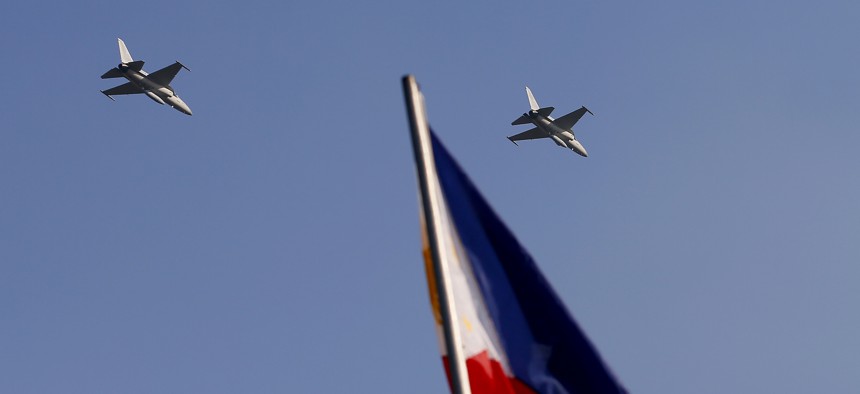
Two of the Philippines' KA-50 fighter jets fly over Manila in this 2015 photo. AP / Bullit Marquez
Great Power Competition Spurs Arms Purchases By Smaller Asian Countries
From sub-hunting planes to fighter jets, Asian nations are arming themselves in response to China’s buildup.
Great power competition, the national security buzzword at the center of the latest U.S. National Defense Strategy, is not just about the chess match between nuclear powers.
Look no further than the Asia-Pacific region, where defense spending is rising, reflecting the desire of the Philippines and other countries for more sophisticated weapons to ward off Chinese encroachment.
“For years, the Philippines military was sort of the El Salvador of Asia and now, for the first time in the country’s history, they’re taking delivery of new fighter jets from Korea,” said Richard Aboulafia, vice president of analysis at the Teal Group consulting firm.
Manila’s plan to buy another dozen South Korean-made FA-50 fighter jets is significant, Aboulafia said, even if they are far less advanced than fifth-generation F-35 Joint Strike Fighters being purchased by Japan, South Korea, Australia, and Singapore.
Related: Shanahan Heads to Asia as White House Beats Drums on Iran
Related: Army Secretary Reveals Weapons Wishlist for War with China & Russia
Related: Naval Task Groups Are Proliferating in the Indo-Pacific
Philippines President Rodrigo Duterte approved spending $5.6 billion over five years to upgrade military equipment.
The Philippines 2019 defense budget is $3.3 billion, according to the International Institute of Strategic Studies’ latest Military Balance+, a database of the world’s militaries. Manila’s budget rose 22 percent between 2018 and 2019. (El Salvador’s 2019 military budget is $124 million, according to IISS.)
Much of the spending is a response to China’s development of new advanced missiles, ships, and warplanes.
“Strong economic growth, regional tension, and aging fleets make for a great market,” Aboulafia said. “There’s great power competition, but with a greater emphasis on self-reliance.”
Shifting relations and new wariness about the reliability of the United States as an ally is driving defense spending in Australia, Japan, and South Korea, he said. Another unique aspect in the region is the diverse defense and aerospace industrial bases, such as those of China, Japan, and South Korea.
What’s hot
Japan and South Korea have been beefing up missile defenses in response to North Korean missile tests. Intelligence aircraft are another hot commodity in this region of expansive oceans and large distances between nations, Aboulafia said.
And anti-submarine warfare has become a priority for Pacific countries. China is expected to add 10 new submarines to its 60-sub fleet by 2020, according to a U.S. Defense Intelligence Agency assessment.
South Korea and New Zealand are among the countries buying the Boeing-made P-8 Poseidon — the Boeing-made anti submarine plane replacing the U.S. Navy’s P-3s.
India and Australia each have eight P-8s in their respective inventories, according to the IISS Military Balance. In February, South Korea and New Zealand placed orders for P-8s. Seoul plans to buy six, while Wellington plans to buy four aircraft.
Japan is replacing its P-3s with indigenously built Kawasaki P-1. Kawasaki has been pitching the plane to Japanese allies at trade shows in the U.S. and abroad hoping to gain more customers.
And the Philippines — one of several nations the disputes China’s territorial claims of islands in the South China Sea — wants old U.S. Navy P-3 submarine hunting planes.
“If they get them, they would be the most capable [aircraft] they ever operated,” Aboulafia said.
Defense budgets across the Asia Pacific are expected to rise from about $480 billion in 2019 to $585 billion by 2024, according to a Teal Group projection. Weapons spending is expected to increase from $134 billion to $165 billion over that same period.
For U.S. and European defense companies, India is seen as a potential multi billion-dollar market. Right now, counties are jockeying to sell New Delhi more than 100 new fighter jets, a deal estimated at $15 billion. India is also planning to buy attack submarines, patrol ships and utility helicopters.




